2015 NISSAN ROGUE SELECT engine overheat
[x] Cancel search: engine overheatPage 248 of 322

SDI2128
Removing the air duct
Remove the air duct*Aif necessary.
1. Remove the clips
*Bwith a suitable tool.
2. Pull the air duct upward
*1and then
sideways
*2.
Install the air duct securely after any inspection
or maintenance work is performed. The engine cooling system is filled at the factory
with a pre-diluted mixture of 50% Genuine
NISSAN Long Life Antifreeze/Coolant (blue) and
50% water to provide year-round anti-freeze
and coolant protection. The antifreeze solution
contains rust and corrosion inhibitors. Additional
engine cooling system additives are not neces-
sary.
WARNING
.
Never remove the radiator or cool-
ant reservoir cap when the engine is
hot. Wait until the engine and
radiator cool down. Serious burns
could be caused by high pressure
fluid escaping from the radiator.
See precautions in “If your vehicle
overheats” (P.6-11) of this manual.
. The radiator is equipped with a
pressure type radiator cap. To pre-
vent engine damage, use only a
genuine NISSAN radiator cap.
CAUTION
. Never use any cooling system ad-
ditives such as radiator sealer. Ad- ditives may clog the cooling system
and cause damage to the engine,
transmission and/or cooling sys-
tem.
. When adding or replacing coolant,
be sure to use only Genuine
NISSAN Long Life Antifreeze/Cool-
ant (blue) or equivalent. Genuine
NISSAN Long Life Antifreeze/Cool-
ant (blue) is pre-diluted to provide
antifreeze protection to �í348 F
(�í378C) . If additional freeze protec-
tion is needed due to weather where
you operate your vehicle, add Gen-
uine NISSAN Long Life Antifreeze/
Coolant (blue) concentrate follow-
ing the directions on the container.
If an equivalent coolant other than
Genuine NISSAN Long Life Anti-
freeze/Coolant (blue) is used, fol-
low the coolant manufacturer’s
instructions to maintain minimum
antifreeze protection to �í348 F
(�í378C) . The use of other types of
coolant solutions other than Genu-
ine NISSAN Long Life Antifreeze/
Coolant (blue) or equivalent may
damage the engine cooling system.
Maintenance and do-it-yourself8-7
ENGINE COOLING SYSTEM
Page 249 of 322
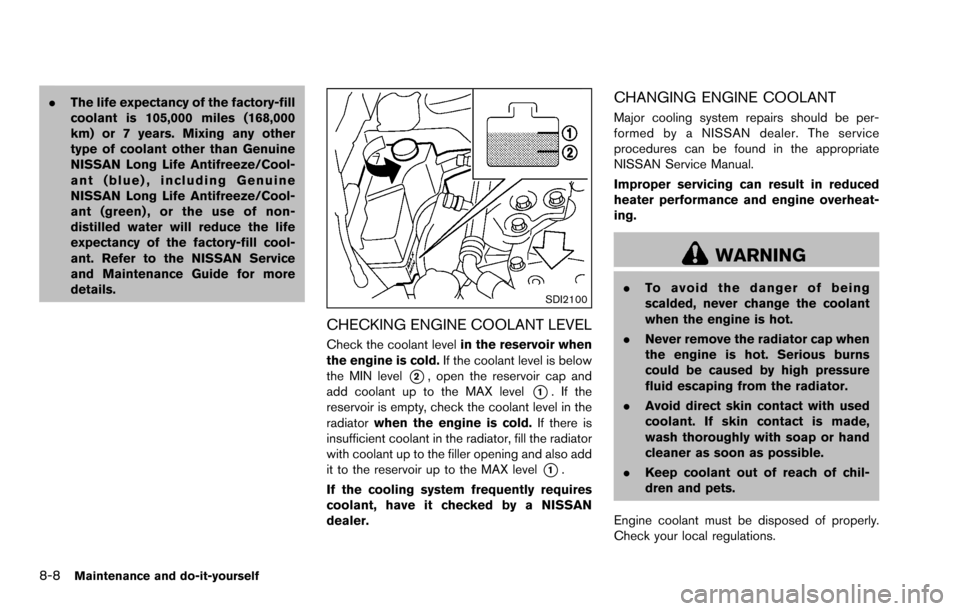
8-8Maintenance and do-it-yourself
.The life expectancy of the factory-fill
coolant is 105,000 miles (168,000
km) or 7 years. Mixing any other
type of coolant other than Genuine
NISSAN Long Life Antifreeze/Cool-
ant (blue) , including Genuine
NISSAN Long Life Antifreeze/Cool-
ant (green) , or the use of non-
distilled water will reduce the life
expectancy of the factory-fill cool-
ant. Refer to the NISSAN Service
and Maintenance Guide for more
details.
SDI2100
CHECKING ENGINE COOLANT LEVEL
Check the coolant level in the reservoir when
the engine is cold. If the coolant level is below
the MIN level
*2, open the reservoir cap and
add coolant up to the MAX level
*1. If the
reservoir is empty, check the coolant level in the
radiator when the engine is cold. If there is
insufficient coolant in the radiator, fill the radiator
with coolant up to the filler opening and also add
it to the reservoir up to the MAX level
*1.
If the cooling system frequently requires
coolant, have it checked by a NISSAN
dealer.
CHANGING ENGINE COOLANT
Major cooling system repairs should be per-
formed by a NISSAN dealer. The service
procedures can be found in the appropriate
NISSAN Service Manual.
Improper servicing can result in reduced
heater performance and engine overheat-
ing.
WARNING
. To avoid the danger of being
scalded, never change the coolant
when the engine is hot.
. Never remove the radiator cap when
the engine is hot. Serious burns
could be caused by high pressure
fluid escaping from the radiator.
. Avoid direct skin contact with used
coolant. If skin contact is made,
wash thoroughly with soap or hand
cleaner as soon as possible.
. Keep coolant out of reach of chil-
dren and pets.
Engine coolant must be disposed of properly.
Check your local regulations.
Page 285 of 322
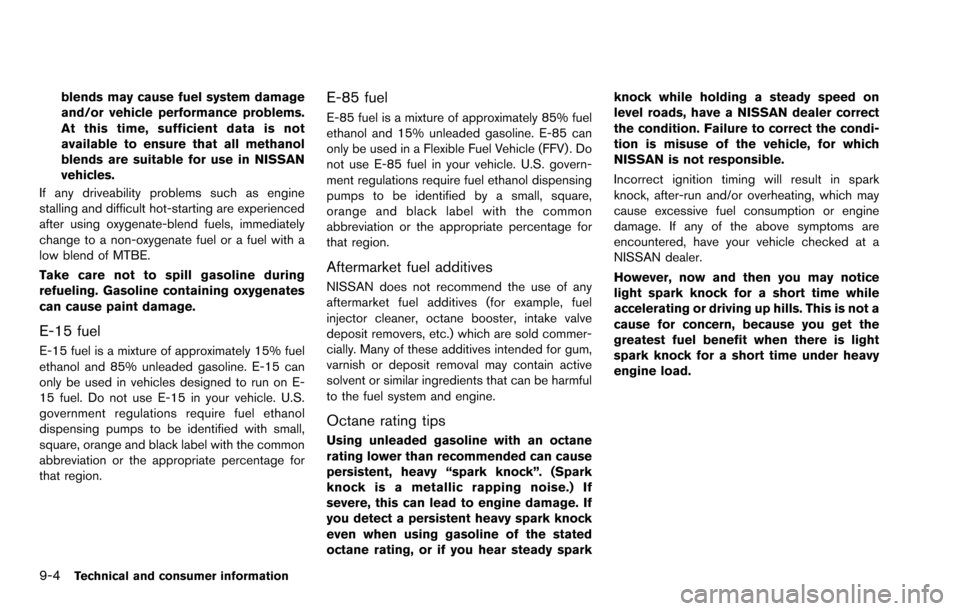
9-4Technical and consumer information
blends may cause fuel system damage
and/or vehicle performance problems.
At this time, sufficient data is not
available to ensure that all methanol
blends are suitable for use in NISSAN
vehicles.
If any driveability problems such as engine
stalling and difficult hot-starting are experienced
after using oxygenate-blend fuels, immediately
change to a non-oxygenate fuel or a fuel with a
low blend of MTBE.
Take care not to spill gasoline during
refueling. Gasoline containing oxygenates
can cause paint damage.
E-15 fuel
E-15 fuel is a mixture of approximately 15% fuel
ethanol and 85% unleaded gasoline. E-15 can
only be used in vehicles designed to run on E-
15 fuel. Do not use E-15 in your vehicle. U.S.
government regulations require fuel ethanol
dispensing pumps to be identified with small,
square, orange and black label with the common
abbreviation or the appropriate percentage for
that region.
E-85 fuel
E-85 fuel is a mixture of approximately 85% fuel
ethanol and 15% unleaded gasoline. E-85 can
only be used in a Flexible Fuel Vehicle (FFV) . Do
not use E-85 fuel in your vehicle. U.S. govern-
ment regulations require fuel ethanol dispensing
pumps to be identified by a small, square,
orange and black label with the common
abbreviation or the appropriate percentage for
that region.
Aftermarket fuel additives
NISSAN does not recommend the use of any
aftermarket fuel additives (for example, fuel
injector cleaner, octane booster, intake valve
deposit removers, etc.) which are sold commer-
cially. Many of these additives intended for gum,
varnish or deposit removal may contain active
solvent or similar ingredients that can be harmful
to the fuel system and engine.
Octane rating tips
Using unleaded gasoline with an octane
rating lower than recommended can cause
persistent, heavy “spark knock”. (Spark
knock is a metallic rapping noise.) If
severe, this can lead to engine damage. If
you detect a persistent heavy spark knock
even when using gasoline of the stated
octane rating, or if you hear steady spark knock while holding a steady speed on
level roads, have a NISSAN dealer correct
the condition. Failure to correct the condi-
tion is misuse of the vehicle, for which
NISSAN is not responsible.
Incorrect ignition timing will result in spark
knock, after-run and/or overheating, which may
cause excessive fuel consumption or engine
damage. If any of the above symptoms are
encountered, have your vehicle checked at a
NISSAN dealer.
However, now and then you may notice
light spark knock for a short time while
accelerating or driving up hills. This is not a
cause for concern, because you get the
greatest fuel benefit when there is light
spark knock for a short time under heavy
engine load.
Page 298 of 322
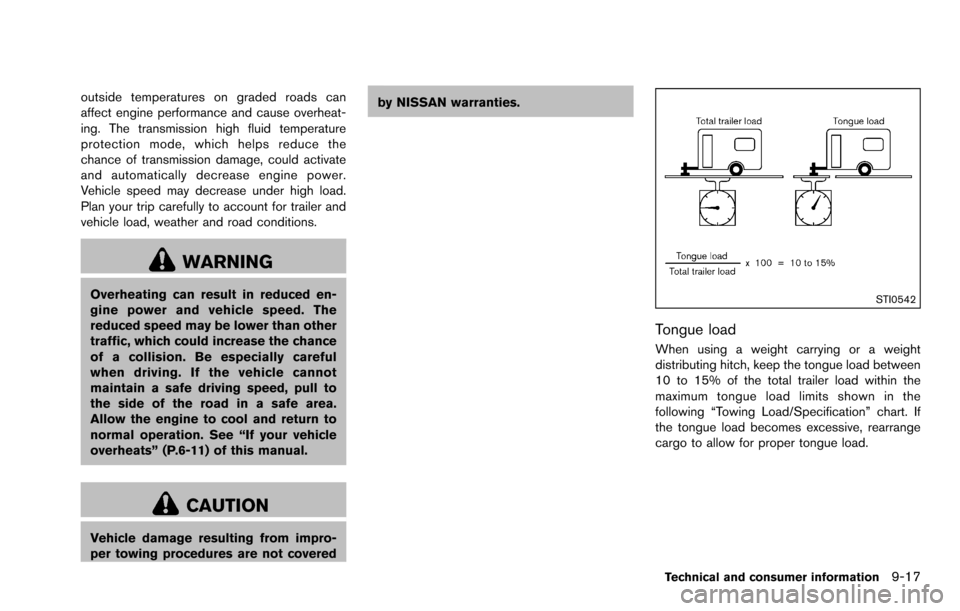
outside temperatures on graded roads can
affect engine performance and cause overheat-
ing. The transmission high fluid temperature
protection mode, which helps reduce the
chance of transmission damage, could activate
and automatically decrease engine power.
Vehicle speed may decrease under high load.
Plan your trip carefully to account for trailer and
vehicle load, weather and road conditions.
WARNING
Overheating can result in reduced en-
gine power and vehicle speed. The
reduced speed may be lower than other
traffic, which could increase the chance
of a collision. Be especially careful
when driving. If the vehicle cannot
maintain a safe driving speed, pull to
the side of the road in a safe area.
Allow the engine to cool and return to
normal operation. See “If your vehicle
overheats” (P.6-11) of this manual.
CAUTION
Vehicle damage resulting from impro-
per towing procedures are not coveredby NISSAN warranties.
STI0542
Tongue load
When using a weight carrying or a weight
distributing hitch, keep the tongue load between
10 to 15% of the total trailer load within the
maximum tongue load limits shown in the
following “Towing Load/Specification” chart. If
the tongue load becomes excessive, rearrange
cargo to allow for proper tongue load.
Technical and consumer information9-17
Page 304 of 322
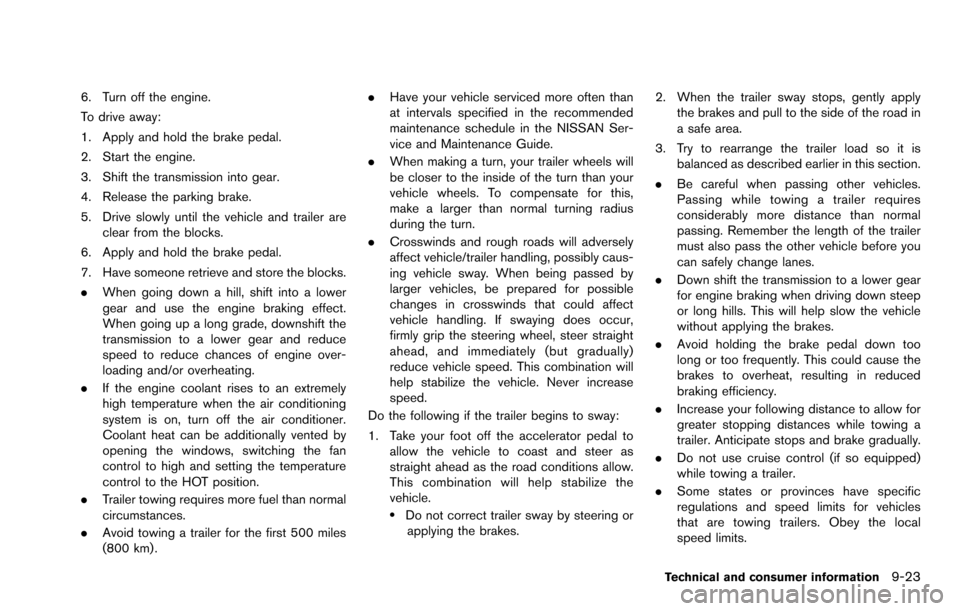
6. Turn off the engine.
To drive away:
1. Apply and hold the brake pedal.
2. Start the engine.
3. Shift the transmission into gear.
4. Release the parking brake.
5. Drive slowly until the vehicle and trailer areclear from the blocks.
6. Apply and hold the brake pedal.
7. Have someone retrieve and store the blocks.
. When going down a hill, shift into a lower
gear and use the engine braking effect.
When going up a long grade, downshift the
transmission to a lower gear and reduce
speed to reduce chances of engine over-
loading and/or overheating.
. If the engine coolant rises to an extremely
high temperature when the air conditioning
system is on, turn off the air conditioner.
Coolant heat can be additionally vented by
opening the windows, switching the fan
control to high and setting the temperature
control to the HOT position.
. Trailer towing requires more fuel than normal
circumstances.
. Avoid towing a trailer for the first 500 miles
(800 km) . .
Have your vehicle serviced more often than
at intervals specified in the recommended
maintenance schedule in the NISSAN Ser-
vice and Maintenance Guide.
. When making a turn, your trailer wheels will
be closer to the inside of the turn than your
vehicle wheels. To compensate for this,
make a larger than normal turning radius
during the turn.
. Crosswinds and rough roads will adversely
affect vehicle/trailer handling, possibly caus-
ing vehicle sway. When being passed by
larger vehicles, be prepared for possible
changes in crosswinds that could affect
vehicle handling. If swaying does occur,
firmly grip the steering wheel, steer straight
ahead, and immediately (but gradually)
reduce vehicle speed. This combination will
help stabilize the vehicle. Never increase
speed.
Do the following if the trailer begins to sway:
1. Take your foot off the accelerator pedal to allow the vehicle to coast and steer as
straight ahead as the road conditions allow.
This combination will help stabilize the
vehicle.
.Do not correct trailer sway by steering orapplying the brakes. 2. When the trailer sway stops, gently apply
the brakes and pull to the side of the road in
a safe area.
3. Try to rearrange the trailer load so it is balanced as described earlier in this section.
. Be careful when passing other vehicles.
Passing while towing a trailer requires
considerably more distance than normal
passing. Remember the length of the trailer
must also pass the other vehicle before you
can safely change lanes.
. Down shift the transmission to a lower gear
for engine braking when driving down steep
or long hills. This will help slow the vehicle
without applying the brakes.
. Avoid holding the brake pedal down too
long or too frequently. This could cause the
brakes to overheat, resulting in reduced
braking efficiency.
. Increase your following distance to allow for
greater stopping distances while towing a
trailer. Anticipate stops and brake gradually.
. Do not use cruise control (if so equipped)
while towing a trailer.
. Some states or provinces have specific
regulations and speed limits for vehicles
that are towing trailers. Obey the local
speed limits.
Technical and consumer information9-23
Page 313 of 322
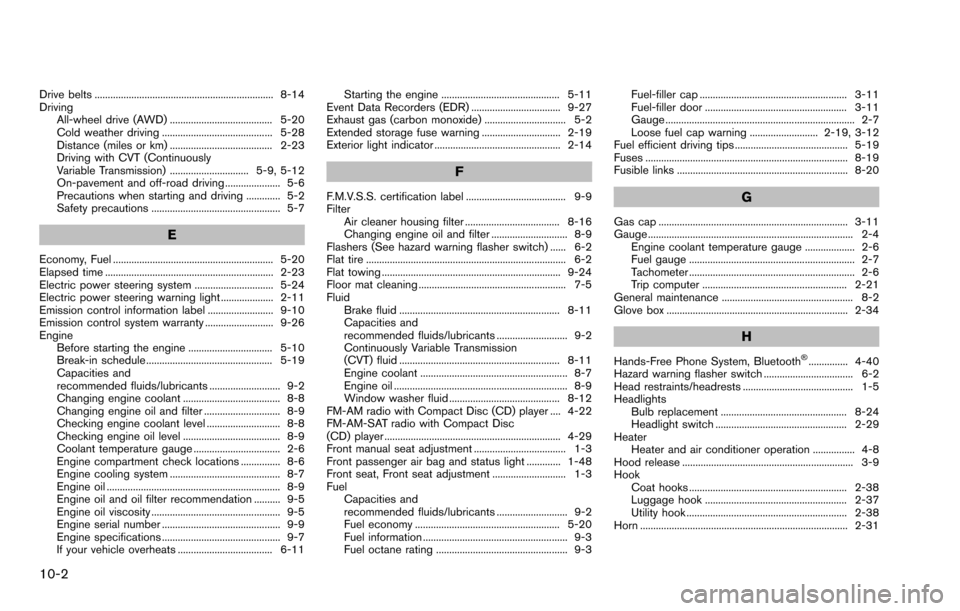
10-2
Drive belts .................................................................... 8-14
DrivingAll-wheel drive (AWD) ....................................... 5-20
Cold weather driving .......................................... 5-28
Distance (miles or km) ....................................... 2-23
Driving with CVT (Continuously
Variable Transmission) .............................. 5-9, 5-12
On-pavement and off-road driving ..................... 5-6
Precautions when starting and driving ............. 5-2
Safety precautions ................................................. 5-7
E
Economy, Fuel ............................................................. 5-20
Elapsed time ................................................................ 2-23
Electric power steering system .............................. 5-24
Electric power steering warning light .................... 2-11
Emission control information label ......................... 9-10
Emission control system warranty .......................... 9-26
EngineBefore starting the engine ................................ 5-10
Break-in schedule ................................................ 5-19
Capacities and
recommended fluids/lubricants ........................... 9-2
Changing engine coolant ..................................... 8-8
Changing engine oil and filter ............................. 8-9
Checking engine coolant level ............................ 8-8
Checking engine oil level ..................................... 8-9
Coolant temperature gauge ................................. 2-6
Engine compartment check locations ............... 8-6
Engine cooling system .......................................... 8-7
Engine oil .................................................................. 8-9
Engine oil and oil filter recommendation .......... 9-5
Engine oil viscosity ................................................. 9-5
Engine serial number ............................................. 9-9
Engine specifications ............................................. 9-7
If your vehicle overheats .................................... 6-11 Starting the engine ............................................. 5-11
Event Data Recorders (EDR) .................................. 9-27
Exhaust gas (carbon monoxide) ............................... 5-2
Extended storage fuse warning .............................. 2-19
Exterior light indicator ................................................ 2-14
F
F.M.V.S.S. certification label ...................................... 9-9
Filter Air cleaner housing filter .................................... 8-16
Changing engine oil and filter ............................. 8-9
Flashers (See hazard warning flasher switch) ...... 6-2
Flat tire ............................................................................ 6-2
Flat towing .................................................................... 9-24
Floor mat cleaning ........................................................ 7-5
Fluid Brake fluid ............................................................. 8-11
Capacities and
recommended fluids/lubricants ........................... 9-2
Continuously Variable Transmission
(CVT) fluid ............................................................. 8-11
Engine coolant ........................................................ 8-7
Engine oil .................................................................. 8-9
Window washer fluid .......................................... 8-12
FM-AM radio with Compact Disc (CD) player .... 4-22
FM-AM-SAT radio with Compact Disc
(CD) player ................................................................... 4-29
Front manual seat adjustment ................................... 1-3
Front passenger air bag and status light ............. 1-48
Front seat, Front seat adjustment ............................ 1-3
Fuel Capacities and
recommended fluids/lubricants ........................... 9-2
Fuel economy ....................................................... 5-20
Fuel information ....................................................... 9-3
Fuel octane rating .................................................. 9-3 Fuel-filler cap ........................................................ 3-11
Fuel-filler door ...................................................... 3-11
Gauge ........................................................................ 2-7
Loose fuel cap warning .......................... 2-19, 3-12
Fuel efficient driving tips ........................................... 5-19
Fuses ............................................................................. 8-19
Fusible links ................................................................. 8-20G
Gas cap ........................................................................ 3-11
Gauge .............................................................................. 2-4 Engine coolant temperature gauge ................... 2-6
Fuel gauge ............................................................... 2-7
Tachometer ............................................................... 2-6
Trip computer ....................................................... 2-21
General maintenance .................................................. 8-2
Glove box ..................................................................... 2-34
H
Hands-Free Phone System, Bluetooth�Š............... 4-40
Hazard warning flasher switch .................................. 6-2
Head restraints/headrests .......................................... 1-5
Headlights Bulb replacement ................................................ 8-24
Headlight switch .................................................. 2-29
Heater Heater and air conditioner operation ................ 4-8
Hood release ................................................................. 3-9
Hook Coat hooks ............................................................ 2-38
Luggage hook ...................................................... 2-37
Utility hook ............................................................. 2-38
Horn ............................................................................... 2-31
Page 315 of 322

10-4
Operation, Indicators for operation ........................ 2-19
Outside air temperature ............................................ 2-17
Outside mirrors ........................................................... 3-14
Overdrive OFF switch ............................................... 5-15
Overheat, If your vehicle overheats ....................... 6-11
Owner’s Manual/Service Manual
order information ......................................................... 9-28
P
Panic alarm .................................................................... 3-7
ParkingBrake break-in ...................................................... 5-25
Parking brake operation ..................................... 5-16
Parking on hills ..................................................... 5-23
Phone Bluetooth
�ŠHands-Free Phone System ......... 4-40
Car phone or CB radio ...................................... 4-39
Power Electric power steering system ....................... 5-24
Power door lock ..................................................... 3-3
Power outlet .......................................................... 2-31
Power windows .................................................... 2-39
Precautions Audio operation .................................................... 4-12
Braking precautions ............................................ 5-25
Child restraints ..................................................... 1-21
Cruise control ....................................................... 5-17
Driving safety ........................................................... 5-7
Maintenance ............................................................. 8-5
On-pavement and off-road driving ..................... 5-6
Seat belt usage ....................................................... 1-9
Supplemental restraint system ......................... 1-41
When starting and driving .................................... 5-2
Push starting ................................................................ 6-11
R
Radio ............................................................................. 4-12 Car phone or CB radio ...................................... 4-39
FM-AM radio with Compact Disc
(CD) player ............................................................ 4-22
Steering wheel audio controls ......................... 4-37
Range (distance to empty) ...................................... 2-23
Rapid air pressure loss ............................................... 5-6
Readiness for inspection/maintenance
(I/M) test ....................................................................... 9-26
Rear center seat belt ................................................. 1-15
Rear door lock, Child safety rear door lock .......... 3-5
Rear seats ...................................................................... 1-4
Rear window defroster switch ................................ 2-29
Rear window wiper and washer switch ............... 2-28
RearView Monitor ......................................................... 4-2
Recorders, Event data ............................................... 9-27
Registering your vehicle in another country .......... 9-8
Remote keyless entry system .................................... 3-5
Reporting safety defects .......................................... 9-26
Rollover ........................................................................... 5-5
Roof Roof rack ............................................................... 2-38
S
SafetyChild seat belts .................................................... 1-19
Towing safety ........................................................ 9-20
Satellite radio operation ............................................ 4-31
Seat adjustment Front manual seat adjustment ............................. 1-3
Front seats ............................................................... 1-3
Seat belt(s) Child safety ........................................................... 1-19
Infants ..................................................................... 1-20 Injured persons .................................................... 1-11
Larger children ..................................................... 1-20
Precautions on seat belt usage .......................... 1-9
Pregnant women .................................................. 1-11
Rear center seat belt .......................................... 1-15
Seat belt cleaning .................................................. 7-6
Seat belt extenders ............................................. 1-18
Seat belt hooks .................................................... 1-15
Seat belt maintenance ....................................... 1-18
Seat belt warning light ....................................... 2-13
Seat belts ................................................................. 1-9
Seat belts with pretensioners .......................... 1-52
Shoulder belt height adjustment ..................... 1-14
Small children ....................................................... 1-20
Three-point type .................................................. 1-11
Seat(s) Seats .......................................................................... 1-2
Security system (NISSAN Vehicle Immobilizer
System) , Engine start ................................................ 2-26
Security system, Vehicle security system ............. 2-24
Servicing air conditioner ........................................... 4-11
Settings ......................................................................... 2-23
Shift lever, Shift lock release ................................... 5-16
Shift lock release Transmission ......................................................... 5-16
Shifting CVT (Continuously
Variable Transmission) .............................. 5-9, 5-12
Shoulder belt height adjustment ............................ 1-14
Spare tire ............................................................. 8-38, 9-7
Spark plugs .................................................................. 8-15
Sport mode switch ..................................................... 5-14
Starting Before starting the engine ................................ 5-10
Jump starting ........................................................... 6-9
Precautions when starting and driving ............. 5-2
Push starting ......................................................... 6-11